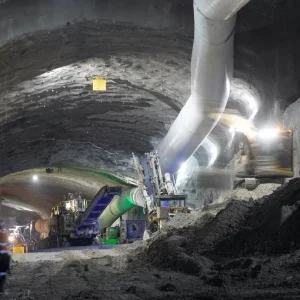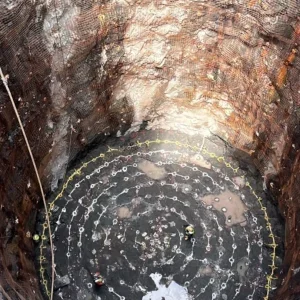As part of HS2 Ltd’s innovation programme, a tower crane on the railway’s Euston approaches site, that would normally be powered by a 500kVA diesel generator to lift loads of up to 24 tonnes, is instead being driven by one less than half that size.
The site is operated by civils contractor, Skanska Costain Strabag joint venture (SCS JV).

The significantly smaller 200kVA generator’s power difference is achieved by pairing it with an energy-storing flywheel system developed and supplied by Silverstone-based engineering specialist Punch Flybrid.
Incorporated inside the Punch Flybrid-supplied unit, the 35cm diameter flywheel is housed in a vacuum chamber to reduce energy-consuming resistance that would result from contact with the air.

The technology matches the power of larger, energy-hungry generators by using the 200kVA generator’s surplus power during the crane’s low load periods to charge the spinning flywheel to very high speeds, equivalent to a ground speed of 550mph. The kinetic energy stored by the flywheel can then be released to support the generator when the crane demands maximum power to lift heavy loads.
The flywheel can perform up to 10 million charging cycles, compared with 3,000 for a typical electric vehicle battery.
Punch Flybrid’s expertise was originally used in F1 motorsport and endurance racing, including the Le Mans 24 Hour, before both sports chose to focus exclusively on electric battery-based hybrid technology.
HS2 innovation manager Rob Cairns said delivering Britain’s zero carbon, high-speed rail network was drawing on skills and technology both in and beyond the rail and construction sectors.
“Our trial work with Punch Flybrid is another great example of how investing in long-term national infrastructure programmes creates opportunities to draw on technology from across the economy that could potentially unlock significant benefits for our industry,” he said.
In May, the Euston trial more than halved the diesel consumption of a single tower crane to 6.3lt per hour, saving 4.8 tonnes of carbon – equivalent to the average monthly CO2 emissions of 40 family cars.
Punch Flybrid managing director Tobias Knichel said the technology was developed in response to F1’s quest for greater efficiency.
“Racing cars typically accelerate and brake around 500 times during a 90-minute F1 grand prix. Each time the car brakes into a corner at high power our flywheel system spins up, storing energy which is then released quickly to boost acceleration performance as the car leaves a bend,” he said.
“We developed our flywheel technology to improve performance and efficiency at the very pinnacle of the automotive industry, but its fundamentals mean there are opportunities to deploy its benefits in other sectors.”
The trail resulted from Punch Flybrid applying to Innovate UK’s ‘Innovate at HS2 2020’ competition. Innovate UK’s innovation lead for rail, Kelvin Davies, said the partnership between HS2 and Punch Flybrid had created the opportunity to explore the potential of automotive technology to save fuel, cut costs, reduce CO2 emissions and create possibilities for future economic growth in the high value manufacturing and engineering sectors.
The development builds on other measures taken to reduce emissions on HS2’s sites.
In May SCS JV achieved HS2’s first completely diesel-free site at the Canterbury Road vent shaft site in South Kilburn, where it had introduced a range of diesel-free technologies and greener equipment.
Last year SCS JV tested and commissioned two GeoPura 250kVA hydrogen power units at the Victoria Road Crossover Box in Ealing, as a direct replacement for diesel generators to power machinery on the site. The trial showed the units were capable of producing the energy required to power equipment for site operations, and they cut carbon and improved air quality for workers and the local community.







